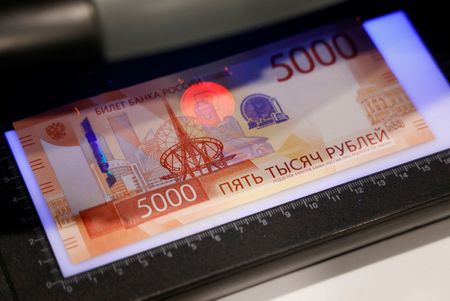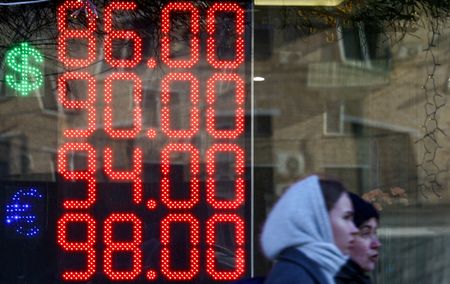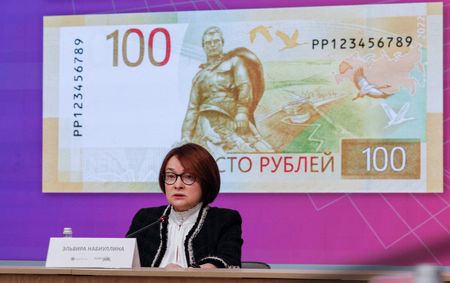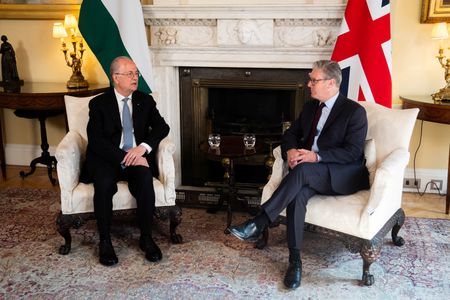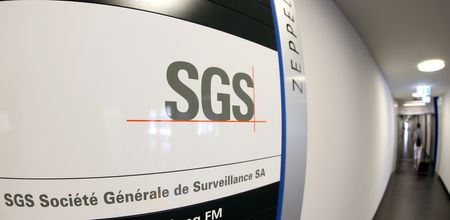MOSCOW (Reuters) -The Russian rouble’s 45% rise against the U.S. dollar since the start of the year has made it one of the world’s best performing currencies – but the sharp appreciation is proving to be a double-edged sword for the heavily sanctioned Russian economy.
The strength of the rouble means that dollar-denominated energy revenues generate fewer roubles for the Russian budget. Russian businesses also argue it is making exports more expensive to buyers in dollars and other currencies.
But President Vladimir Putin’s central bank governor, Elvira Nabiullina, argues that a softer currency would be a sign of economic vulnerability.
Nabiullina, who on Friday announces the latest interest rate decision, says the exchange rate is not just there to please exporters, stressing that the strong rouble is a product of the tight monetary policy needed to fight stubbornly high inflation.
The following explains some of the factors behind the rouble’s rise and its implications.
WHY HAS THE ROUBLE RISEN SO MUCH AGAINST THE DOLLAR?
The rouble has strengthened about 45% against the dollar this year. The rise is driven primarily by the central bank’s tight monetary policy and optimism after U.S.-Russia talks in February raised hopes for a peace settlement in Ukraine.
Interest rates on rouble deposits have also soared above 20%, making the currency attractive to savers and as a speculative trade for its yield. At the same time, high borrowing costs have slowed imports, reducing demand for foreign currency.
The weakness of the U.S. currency, whose index lost 6.6% since President Donald Trump’s “Liberation Day” tariff announcement on April 2, has also helped the rouble.
Although the central bank says there is a freely floating exchange rate, it has been selling the Chinese yuan, its only major intervention tool, to support the rouble. When the rouble strengthens against the yuan, its rate against the dollar strengthens as well to avoid arbitrage.
The stronger rouble helps the regulator fight inflation by making imports cheaper. VTB’s First Deputy CEO Dmitry Pyanov alleged recently this is part of a deliberate strategy.
The rouble is also supported by currency controls introduced after the start of the war in Ukraine to prevent capital flight but recently exporters have been repatriating more foreign currency revenues than they are obliged to.
HOW IS THE ROUBLE TRADED?
Since sanctions hit the Moscow Stock Exchange (MOEX) in 2024, the rouble trades over-the-counter against the dollar and euro. Banks report their quotes to the central bank, which uses them to set the official rate.
This market is opaque since only the central bank sees full transaction data. Some smaller, mostly non-Russian banks report quotes to market data providers.
The rouble trades against the yuan on MOEX. Dollar/rouble futures, which also trade on MOEX, provide some market guidance on exchange rate. There is no black market rate for foreign currency in Russia.
The rouble is no longer a major internationally traded currency and many Western companies and banks have left Russia. But Russia remains a top oil and agriculture exporter and the world’s 11th largest economy.
Russia’s push to shift trade into non-Western currencies, especially the yuan, may have implications for the global dominance of the U.S. dollar in the long-term. Major developing economies like China and India are watching closely.
WHY IS ROUBLE-YUAN THE BIGGEST PAIR?
The yuan has overtaken the dollar as Russia’s most traded foreign currency. In 2024, 95% of Russia’s trade with China was settled in yuan and roubles.
Yuan-rouble trading volumes on the Moscow Exchange reached 33 trillion roubles ($420 billion) in 2024. Russia’s total trade with China hit a record $245 billion. The rouble is up against the yuan by 25% this year.
Energy firms repatriate yuan earnings, while importers use yuan to buy goods. Most analysts now focus on the rouble/yuan rate, not the dollar.
WHAT DOES THE RUSSIAN GOVERNMENT SAY ABOUT THE ROUBLE?
The government wants a weaker rouble to boost budget revenues. The 2025 budget assumes an average rate of 94.3 roubles per dollar, but the current rate is around 78.
If the rouble stays strong, VTB analysts estimate the budget could lose 2.4% of its revenues this year.
Exporters, from oil to metals to agriculture, are also hurting. A stronger rouble makes their revenues shrink. Many officials and business leaders say they would prefer a rate of 100 to the dollar.
Putin has not spoken publicly about the rouble’s strength in recent months.
HOW DO ORDINARY RUSSIANS VALUE THE ROUBLE?
The public still sees the dollar as the benchmark, even though yuan use is rising. Cash dollars and euros remain available in bank branches, though there are now far fewer exchange offices than in previous decades.
Sanctions have made foreign travel and dollar and euro international transfers harder, reducing demand for cash dollars.
In the first quarter of early 2025, Russians bought about 200 billion roubles’ worth of foreign currency, unchanged from a year earlier. High rouble interest rates have made foreign currency savings less attractive.
WHAT LIES AHEAD FOR THE ROUBLE?
Analysts have warned for months that the rouble is overvalued, but the currency has defied their forecasts so far.
The central bank is widely expected to cut interest rates at its upcoming meeting. If it does, market rates will fall as well, prompting savers to pull money from rouble deposits. That could weaken the currency.
A bigger test looms in early September, when a 50-day deadline set by U.S. President Donald Trump for Russia to show progress toward peace in Ukraine expires. If new U.S. sanctions targeting buyers of Russian oil follow, the rouble could come under renewed pressure.
The last time the rouble weakened significantly was in November 2024, after Washington sanctioned Gazprombank, which had handled oil and gas payments.
A source close to the central bank pointed to Reuters that when the regulator cut the key rate from 17% to 11% between February and July 2015, the rouble took several months to weaken gradually. This is the regulator’s expectation this time.
(Writing by Gleb Bryanski; editing by Guy Faulconbridge and Toby Chopra)

